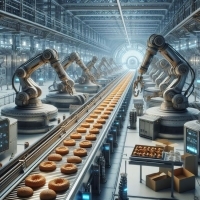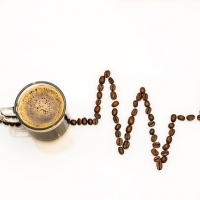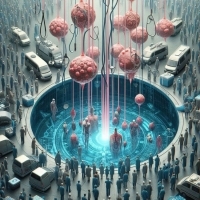움직일 수 없는 식물이 살아남고, 번식하기 위한 엄청난 전략 - 알고보면 너무 재미있는 이야기입니다.
에센셜오일의 원재료인 식물에 대해 알아보니 식물이 생각 이상으로 똑똑하고 전략적인 화학자라는 생각이 들었습니다. 식물마다 다른 수많은 성분들이 있는데, 놀라운 점은 동일한 자원과 환경하에 있더라도 스스로 자신이 필요한 다른 성분들을 만든다는 사실입니다. 식물들은 왜 힘들고 귀찮게 서로 다른 물질을 만들어낼까요?
먼저 동물에 대해 생각해 보겠습니다. 동물은 움직일 동(動)자를 씁니다. 동물은 움직일 수는 있으나 식물이나 자신보다 약한 동물을 먹지 않으면 생존할 수 없어서 ‘종속영양생물’이라고 합니다. 이에 반해 식물은 인위적인 간섭이 없다면 맨 처음 태어난 그 자리에서 일생을 보내야만 합니다. 쉽지 않은 삶의 조건에서 똑똑한 화학자인 식물은 어쩔 수 없이 스스로 생존하고, 성장하고, 외부의 공격으로부터 자신을 보호하면서 최종적으로는 종족 번식의 의무까지 완수하는 ‘독립영양생물’이 되었습니다.
식물은 생존과 성장을 위해서 기본 연료인 단백질, 포도당과 지질을 생산하기 위한 ‘광합성’이란 과정을 진행합니다 (그림1). 또한 자기 자신을 보호하고 방어하기 위해 페놀류나 테르펜노이드류와 같은 ‘파이토케미칼’을 만듭니다.
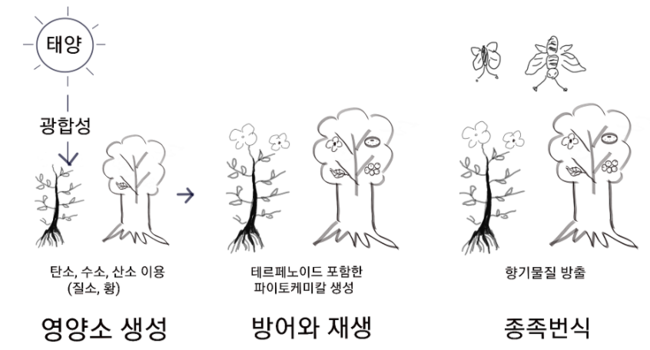
그림1 독립영양생물인 식물의 주요 기능
화학적으로 보면, 자연이 주는 기본 재료에서 탄소, 수소, 산소를 주재료로 사용하고 때로는 질소나 황 등을 첨가하면서 만든 파이토케미칼을 통해 화학적인 신호로 소통하고, 살균하고, 건강하게 생존하고 부패가 되지 않도록 자신을 보호하고 방어하게 됩니다. 예를 들면 숲 향기가 나서 방향제로 인기가 있는 피톤치드도 식물이 병원균이나 해충으로부터 자신을 지키고 때로는 공격하기 위해 만드는 공격용 화학무기입니다. 페놀은 나비 유충의 성장을 지연시키고, 탄닌은 화학적 보호막으로 작용해서 잎사귀의 맛을 떫게 만들어 포식자가 다시는 먹고 싶지 않게 하고, 쉽게 소화되지 않도록 만듭니다. 자스몬산도 곤충의 소화력을 방해합니다. 이러면 당연히 적군들이 꺼려하는 먹이감이 됩니다. 식물은 이런 공격용 화학무기를 가지고 그 농도를 조절하면서 주변 식물과 경쟁하며, 세균, 바이러스, 곤충이나 동물에 대항하여 엄청난 화학전을 진행하고 있습니다. 눈에 보이시나요?
식물이 만드는 파이토케미칼은 방어와 공격 외에 재생과 회복이란 임무를 수행합니다. 파이토케미칼은 외부 공격으로 인해 손상된 세포를 재생시키고, 통증도 억제합니다. 버드나무에 있는 살리실산도 감염과 상처를 회복시키고 통증을 억제하는 작용을 합니다. 에센셜오일 안에는 이런 놀라운 효능의 파이토케미칼 중 일부 성분이 농축되어 있어서, 세포를 재생시키고, 통증을 억제하고, 중추신경을 자극하거나 진정시킬 수 있습니다. 인간이 식물의 방어제이고 화학용 공격무기이자 자가치료제를 이용하는 것입니다.
최종 목적인 종족 번식을 위해서는 더욱 영리한 전략을 가지고 있습니다. 식물이 분비하는 일부 성분은 호르몬 유사물질로 자신의 분신인 씨앗이나 꽃가루를 이송해줄 곤충이나 동물을 적극적인 방법으로 유혹하게 됩니다. 꽃가루 받이 준비가 끝난 꽃들이 그냥 좋은 향을 뿜어서 아무 곤충이나 동물을 유혹하는 것이 아닙니다. 식물이 이렇게 치밀하다니 믿어지지가 않습니다.
또한 아무 때나 꽃을 피워 배송자들을 유혹하는 것도 아닙니다. 복수초나 홍매처럼 키가 작은 식물들은 아직도 눈이 희끗희끗 남아있는 추위 속에서 남보다 서둘러 꽃을 피워 주위 식물에 대한 경쟁우위를 선점하고 목표한 곤충을 유혹합니다. 달맞이꽃처럼 밤에 꽃을 피우는 식물들은 꽃가루를 이송하기에 적합한 곤충이 밤에만 활동하는 나방이라서 남들이 다 자는 밤에 누구보다 화려하게 꽃을 피우고 아침에 사그라집니다. 어떤가요? 식물들은 똑똑한 화학자이자, 정말 엄청난 전략가 아닐까요?
글 = 정지윤 약사, 통합의학석사, 한국여성건강연구소대표
Plants are smart and strategic chemists
When I learned about plants, the raw material of essential oil, I thought that plants were smarter and more strategic chemists than I thought. There are a lot of different ingredients in different plants, and what's amazing is that even under the same resources and environment, they make different ingredients that they need. Why do plants create different substances?
Let me think about animals first. Animals use a moving motion (動) letter. Animals can move, but they cannot survive unless they eat plants or animals weaker than themselves, so they are called 'dependent nutrients'. Plants, on the other hand, must spend their lives in the place where they were first born, unless there is artificial interference. Under difficult living conditions, plants, which are smart chemists, are forced to survive, grow, protect themselves from external attacks, and eventually become "independent nutrients" that fulfill their obligation to reproduce their species.
Plants undergo a process called 'photosynthesis' to produce protein, glucose, and lipids, which are basic fuels, for survival and growth (Figure 1). They also make 'phytochemicals' such as phenols and terpenoids to protect and defend themselves.
Figure 1 Key functions of plants that are autotrophic organisms
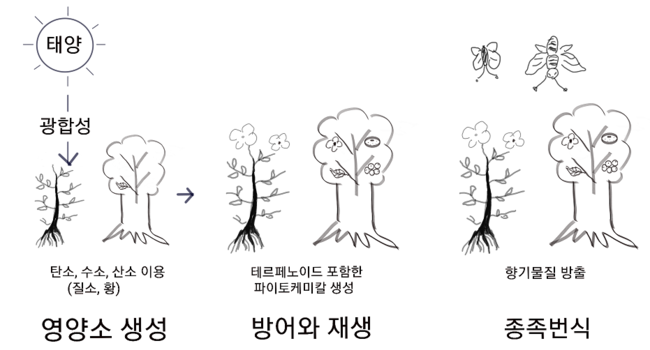
Chemically, it uses carbon, hydrogen, and oxygen as the main ingredients in the basic materials given by nature, and sometimes by adding nitrogen or sulfur to communicate, sterilize, survive healthily, and protect itself from decay. For example, phytoncide, which has a forest scent and is popular as an air freshener, is an offensive chemical weapon that plants make to protect themselves from pathogens and pests and sometimes attack them.
Phenol delays the growth of butterfly larvae, and tannins act as a chemical protective film, making the leaves taste sour, making predators never want to eat again, and not easily digest. Jasmonic acid also interferes with insects' digestion. This, of course, becomes a prey that the enemy is reluctant to eat. Plants have these offensive chemical weapons, and they compete with the surrounding plants while controlling their concentrations, and they're doing a tremendous chemical war against bacteria, viruses, insects, and animals. Can you see it?
Phytochemicals made by plants perform tasks of regeneration and recovery in addition to defense and attack. Phytochemical regenerates cells damaged by external attacks and suppresses pain. Salicylic acid in willow trees also works to restore infection and wounds and suppress pain. The essential oil is rich in some of these amazingly effective phytochemicals, which can regenerate cells, suppress pain, stimulate or calm the central nervous system. Humans are plant defense, chemical attack weapons, and self-medication.
We have a smarter strategy for breeding the species, which is the end goal. Some of the components secreted by plants are hormone-like substances that attract insects or animals that will transport their own self-immolation, seeds or pollen, in an active way. Flowers that are ready to receive pollen don't just attract any insects or animals by emitting good scents. I can't believe the plants are so dense.
Nor does it tempt shippers by blooming at any time.
Short plants, such as violet plants and red plums, bloom faster than others in the cold, which still leaves their eyes gray, preoccupying a competitive advantage over the surrounding plants and attracting targeted insects. Plants that bloom at night, like moonflowers, bloom more splendidly than anyone else at night and disappear in the morning because insects suitable for transporting pollen are moths that are only active at night. How is it? Aren't plants smart chemists, and really a great strategy?
저작권(c); 본 기사의 무단전재 및 재배포금지
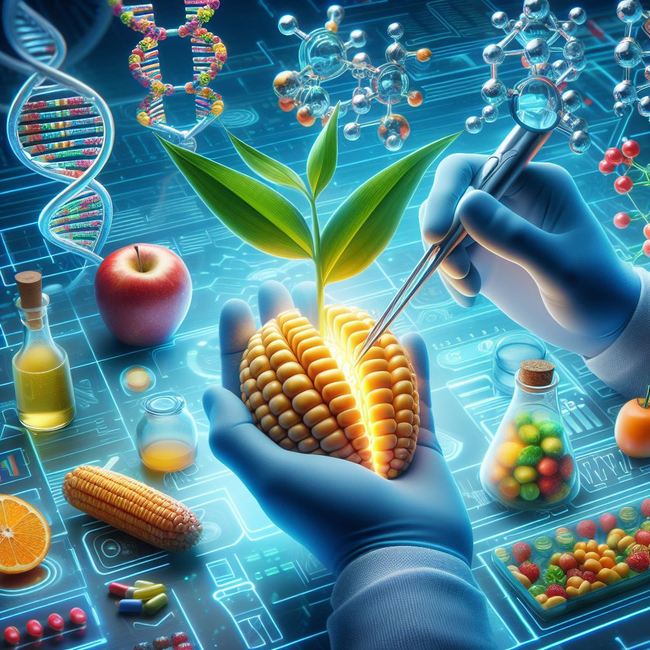 유전자조작기술 (CRISPR)
현재 유전자 조작 기술은 CRISPR (Clustered Regularly Interspaced Short Palindromic Repeats) 기술이 주도하고 있습니다. 이 기술은 특정 유전자를 정확하게 수정하는 강력한 도구로, 미국의 여러 기업들이 이 분야에서 선두를 달리고 있습니다.여기 몇몇 주목할만한 CRISPR 기업들이 있습니다:Verve Therapeutics: Cambridge, Massachusetts에 위치한 Verve Therapeutics는 심혈...
유전자조작기술 (CRISPR)
현재 유전자 조작 기술은 CRISPR (Clustered Regularly Interspaced Short Palindromic Repeats) 기술이 주도하고 있습니다. 이 기술은 특정 유전자를 정확하게 수정하는 강력한 도구로, 미국의 여러 기업들이 이 분야에서 선두를 달리고 있습니다.여기 몇몇 주목할만한 CRISPR 기업들이 있습니다:Verve Therapeutics: Cambridge, Massachusetts에 위치한 Verve Therapeutics는 심혈...
 스타틴계열 약물이 뭐예요?
흔히 자주 듣는 의학전문 용어 중에 스타틴계열 약물이라는 얘기를 자주 들어 보셨을 겁니다. 약물의 주요 성분의 이름이 ~스타틴 이라고 끝나는 데 따라 붙은 이름인데요. 주로 심혈관계에 작용하는 약물들이 포함됩니다.리피토나 조코와 같은 세계적인 베스트셀러 약품도 이런 스타틴 계열 약물중의 하나입니다.정보가 도움이 되신다면, ...
스타틴계열 약물이 뭐예요?
흔히 자주 듣는 의학전문 용어 중에 스타틴계열 약물이라는 얘기를 자주 들어 보셨을 겁니다. 약물의 주요 성분의 이름이 ~스타틴 이라고 끝나는 데 따라 붙은 이름인데요. 주로 심혈관계에 작용하는 약물들이 포함됩니다.리피토나 조코와 같은 세계적인 베스트셀러 약품도 이런 스타틴 계열 약물중의 하나입니다.정보가 도움이 되신다면, ...

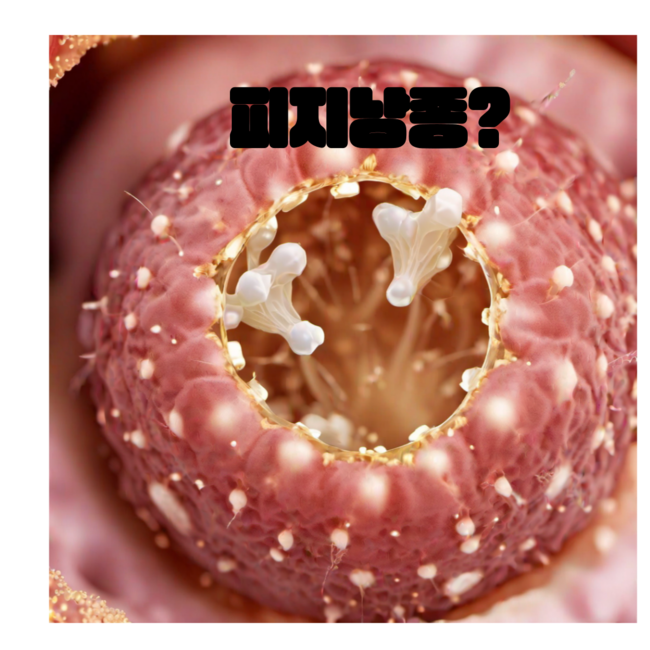 피지낭종 - 말랑말랑할 줄 알았다면 이 영상을 잘 보세요
피지낭종 - 말랑말랑할 줄 알았다면 이 영상을 잘 보세요
 교통혁명과 로봇으로 여가시간이 늘어난 다면.
교통혁명과 로봇으로 여가시간이 늘어난 다면.
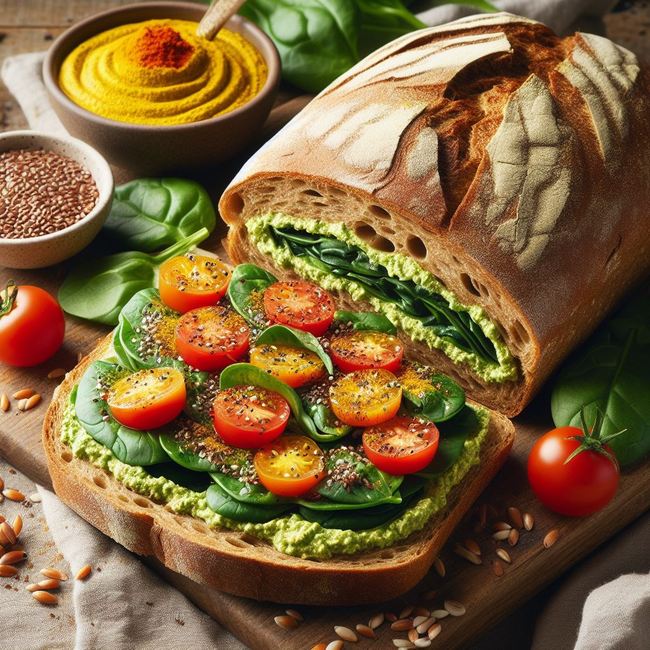 면역력 높여주는 빵이라고?
면역력 높여주는 빵이라고?
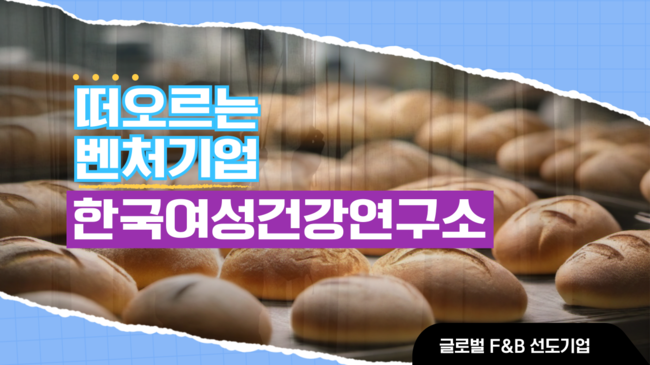 한국여성건강연구소 벤처기업지정 예고
한국여성건강연구소 벤처기업지정 예고




 교통혁명과 로봇으로 여가시간이 늘어난 다면.
교통혁명과 로봇으로 여가시간이 늘어난 다면.

